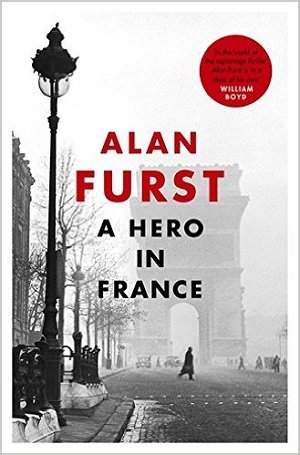 Written by Alan Furst — Paris in spring conjures up images of joie de vivre, recalling Sinatra singing about chestnuts in blossom and holiday tables under the trees. But in the spring of 1941 a darkness hangs over Paris – Nazis occupy the much of France, including the capital, imposing a curfew at night, while across the Channel British cities are being bombed nightly. With Hitler’s army pushing west, it looks certain the Allies will lose the war, yet the French continue to fight back.
Written by Alan Furst — Paris in spring conjures up images of joie de vivre, recalling Sinatra singing about chestnuts in blossom and holiday tables under the trees. But in the spring of 1941 a darkness hangs over Paris – Nazis occupy the much of France, including the capital, imposing a curfew at night, while across the Channel British cities are being bombed nightly. With Hitler’s army pushing west, it looks certain the Allies will lose the war, yet the French continue to fight back.
One of these Resistance fighters is called Mathieu, a nom de guerre – his real identity is not revealed until the final pages. A former tank commander, unable to serve because of injury, he now leads a cell helping downed RAF airmen to Spain in order to rejoin the war.
Mathieu is a creation typical of the espionage master Alan Furst. He’s a quiet loner whose outward obedience masks a contempt for the fascists taking over Europe, from the small-time thugs on the street to the bigger thugs ruling the Reich. Between journeys escorting RAF men to safety he entertains women in his small hotel room, or arranges meetings with other members of La Resistance. There are fighters to recruit, funds to raise and, just like any other spring in Paris, there are cafes and nightclubs to frequent.
Despite the best efforts of La Resistance this spring in Paris is different – the Germans haunt the nightclubs, and they have a new plan to stop the flow of British airmen back to their units. Mathieu must tread lightly if his Resistance cell is to live beyond the six months these cells usually survive. Mathieu and the disparate group he is part of must be obedient and obliging, but most of all they must be cunning.
With the Germans and the Allies in close contact Furst’s knack for the subtle details that reveal character is put to the test, and it doesn’t always pass. The subtlety of characterisation and morality that defined earlier novels in this series frequently lapses, and too much is explained – even simple French phrases are over-explained, pulling the narrative out of wartime France and making it feel more like a middle school language class. Yet the author remains the master of research, and the level of detail he adds to the descriptions of planes and aerial battles bringing you right back into the moment.
Here is where Furst shines. His skill is that we know how the war will play out. The fighters in La Resistance await the US entry into the war – and we all know how that ended. Yet every moment is still tense and filled with expectation. Some of that skill is blunted – aspects of the series that overlap start to seem repetitive, with a plotline from Midnight in Europe repeated almost exactly, but happening to a different character, and the mention of the Brasserie Heininger (which appears in every one of Furst’s novels) feeling tacked on, despite Furst’s writing feeling most at home in Paris.
Alan Furst is still the best writer of espionage fiction currently active. Those who eagerly anticipate each new novel will know that even at his worst he is still engaging and exciting, even if his newer books do not feel as fresh as the opening pages of Night Soldiers. And this is certainly not Furst at his worst. As the end of 1941 approaches and with it the turning point in the war, I continue to look forward to each new installment in the Night Soldiers series.
Our site offers plenty more book set in Paris, and World War II crime fiction.
Weidenfeld & Nicolson
Print/Kindle/iBook
£8.99
CFL Rating: 4 Stars










I’ve read all the Furst books and love the early ones, especially. I will look forward to adding this one to my collection, though I fear the reviewer’s comments about the need for a little freshening up are probably well taken! But for those who have not read them all, Furst is a revelation.